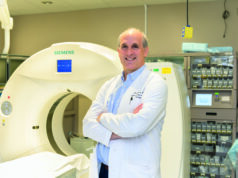
Women who underwent embolization for the treatment of uterine fibroids experienced improved sexual function and a higher overall quality of life. The research, part of a French multicentre study, presented at the Society of Interventional Radiology’s Annual Scientific Meeting, also found the vast majority of women treated with the procedure sustained improvement for more than a year.
“Women with uterine fibroids often experience troubling symptoms and significant discomfort, which diminish their sex lives and reduce their quality of life. These symptoms include heavy menstrual bleeding, pain during sexual intercourse, pelvic pain and back and leg pain,” said Helene Vernhet-Kovacsik, the study’s lead researcher and an interventional radiologist in the department of Vascular Radiology at Centre Hospitalier Universitaire, Montpellier in France.
“Working in collaboration with a patient’s gynaecologist, interventional radiologists can now offer these women a treatment option which alleviates chronic pain within the female reproductive system and allows the opportunity to lead a full and more normal life.”
Researchers from 25 centres throughout France conducted a prospective study involving 264 women who underwent uterine fibroid embolization to treat benign fibroid growths.
Study participants completed the Uterine Fibroid Symptom and Health-related Quality of Life Questionnaire (UFE-QoL) to report their quality of life before and one year post treatment. The women were also asked to complete the Female Sexual Function Index, or FSFI (a brief questionnaire developed for the specific purpose of assessing sexual function in clinical trials), to track their sexual function, including items such as desire, arousal, lubrication and orgasm.
At the beginning of the study, 189 of the 264 women suffered abnormally heavy menstrual bleeding and 171 experienced pain, among other symptoms associated with pelvic pressure. When researchers followed up with participants a year after treatment, only 39 of those 189 continued to experience abnormal bleeding and only 42 of the 171 women still dealt with pelvic pressure. Nearly eight in 10 (78.8%) women who completed self-reported assessments at the one-year mark demonstrated improvement in sexual function, including pain, desire, arousal and satisfaction—as measured by the FSFI.
Additionally, about nine in 10 (90.2%) women who completed the UFE-QoL assessment reported a better overall quality of life, with average scores increasing from 45 at treatment to 71 one year after. UFE-QoL scores range from 0 to 100, with higher scores indicating a better health-related quality of life.
“Through our expertise in performing image-guided therapy, interventional radiologists pioneered the treatment of uterine fibroids using this much less invasive technique. Compared to surgery such as hysterectomy, which requires significant recovery time and increases health care cost burdens, uterine fibroid embolisation gives women the opportunity to return to their daily routine as quickly as possible after treatment,” said Marc R Sapoval, one of the study’s co-authors and an interventional radiologist at Hôpital Européen in Paris, France.
“My patients have told me their general well-being has improved because they are not as tired and feel less depressed because of the reduction in bleeding, pain and the other related symptoms of uterine fibroids.”
“The significant quality of life improvements demonstrated in this study should help put an end to any debate on the effectiveness of uterine fibroid embolization and its numerous benefits for women with symptomatic fibroids,” said Alan H Matsumoto, an interventional radiologist and professor and chair of the Department of Radiology and Medical Imaging at the University of Virginia, Charlottesville, USA, and an expert in minimally invasive treatments for uterine fibroids. “Although in use for more than 20 years, the procedure is rarely offered as a treatment option to women in the USA, despite the fact that it is a proven, safe and effective treatment that spares women from the risks and long-term consequences of a hysterectomy,” said Matsumoto, who is also the SIR 2015–16 president.










